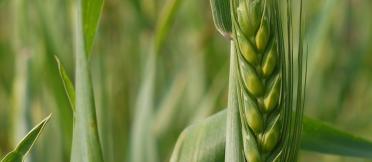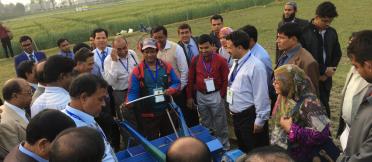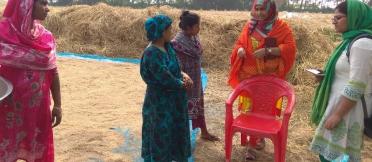Wheat blast—caused by airborne spores or through contaminated seed—was found for the first time in Bangladesh in February 2016. Previously it had been confined to South America, where it has plagued Brazil, Argentina, Bolivia and Paraguay since the mid-1980s.
Dr Pawan Kumar Singh is Head of Wheat Pathology at the International Maize and Wheat Improvement Centre (CIMMYT), based in Mexico. He is also leader of a four-year, ACIAR-supported multilateral collaboration between CIMMYT, the Bangladesh Wheat and Maize Research Institute (BWMRI) and other stakeholders. He says wheat blast thrives in tropical environments with high humidity, and that the fast-moving infection shrivels and deforms wheat spikes within a matter of days. This gives farmers no chance to apply fungicide and causes grain losses of up to 100% in severe cases.
‘Currently wheat blast-vulnerable districts cover 60–65% of the total wheat area of Bangladesh,’ Dr Mohammad Israil Hossain, director-general of BWMRI, says. ‘If there is a typical hot, wet year conducive to wheat blast it will be disastrous. This will have a huge impact on food security, with an estimated economic loss of US$17 million [A$26 million] considering a 10% wheat blast-induced yield loss.’
Southwestern Bangladesh is particularly susceptible, and it was there—at Dighirpara, Meherpur: a wheat blast hotspot near the Bangladesh–India border—that Mr Hossain was forced to write off his entire crop of the wheat variety BARI Gom 24 when wheat blast swept across 15,000 ha in eight districts in 2016.
In the coming year we hope to cover 10% of Bangladesh’s growing area with new-variety seed and the following year we hope that will be at least 30%.
Dr Mohammad Israil Hossain
‘That was only about 3% of the total wheat-growing area so it did not affect the national yield that much,’ Dr Hossain says.
‘However, the alarming message is that it’s spreading to new districts each consecutive year even under unfavourable disease development conditions.’
Dr Singh adds that researchers are also seeing worrying evidence that the fungus could eventually adapt to lower temperatures, potentially exposing additional areas of Bangladesh, Asia and the world more generally to enormous risk.
‘Our wheat-growing area this year is roughly 0.34 million hectares, with a particularly good yield of about 3.7 t/ha, from the 8–10 million hectares that are suitable for this crop,’ Dr Hossain says.
Communicating with the wheat sector in Bangladesh is complicated by the prevalence of small-area producers: 1.7 million in total. Educating and training extension officers is part of the project, and workshops hosted by CIMMYT and BWMRI have been delivered to dozens of participants. ‘Our major initial challenges were identifying the disease, building awareness and establishing a “wheat holiday” [during which alternative crops were grown to minimise reinfection rates]. The wheat holiday is now over for the most vulnerable districts, so we have been working on replacing susceptible varieties,’ Dr Hossain says.





